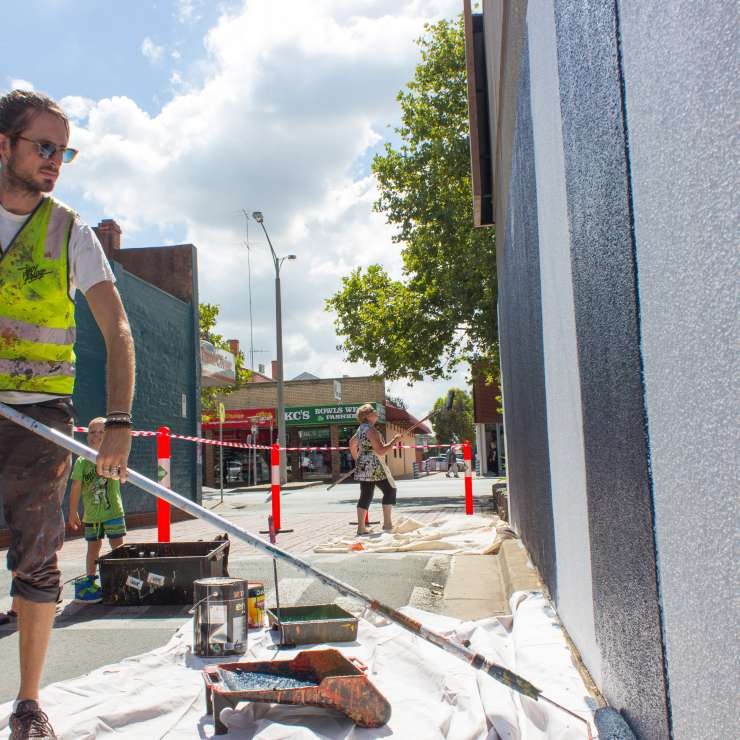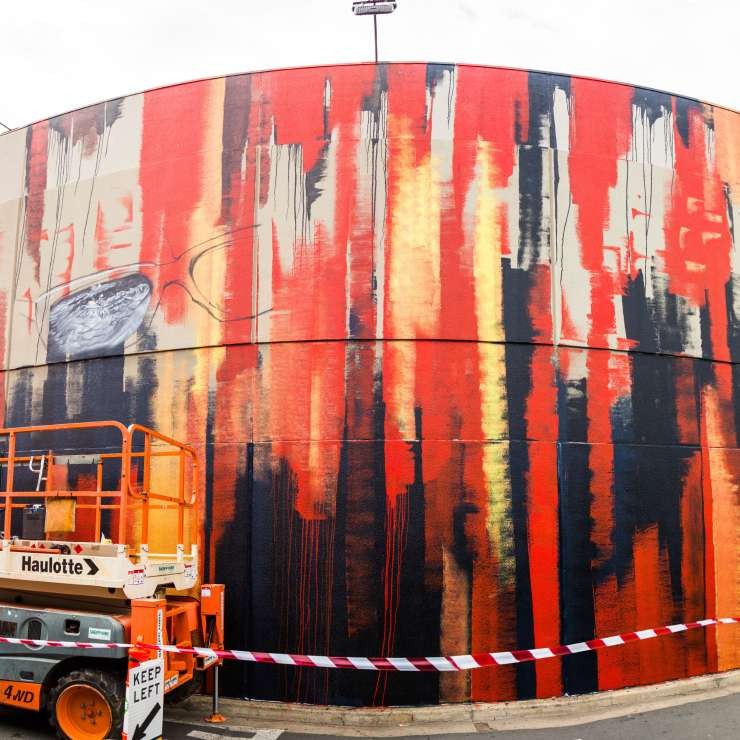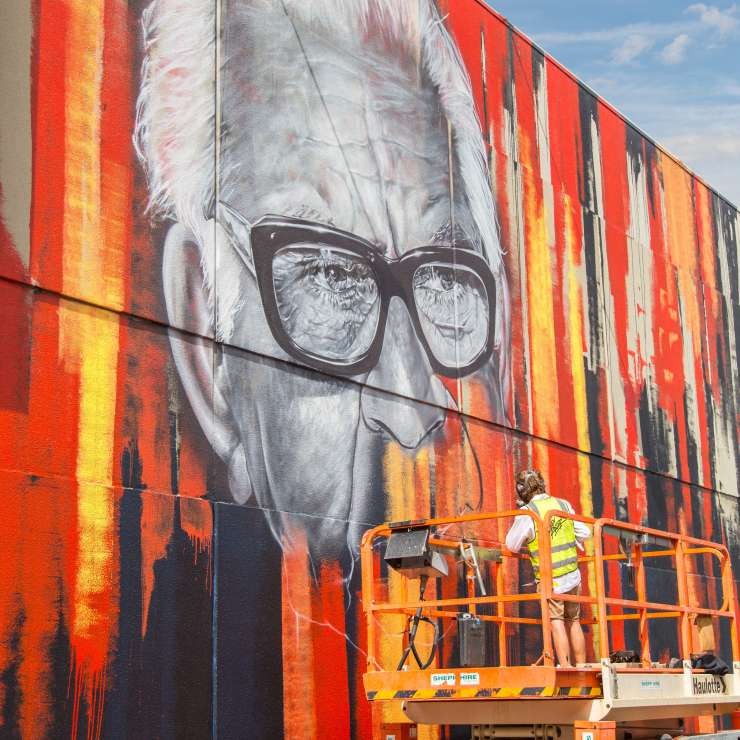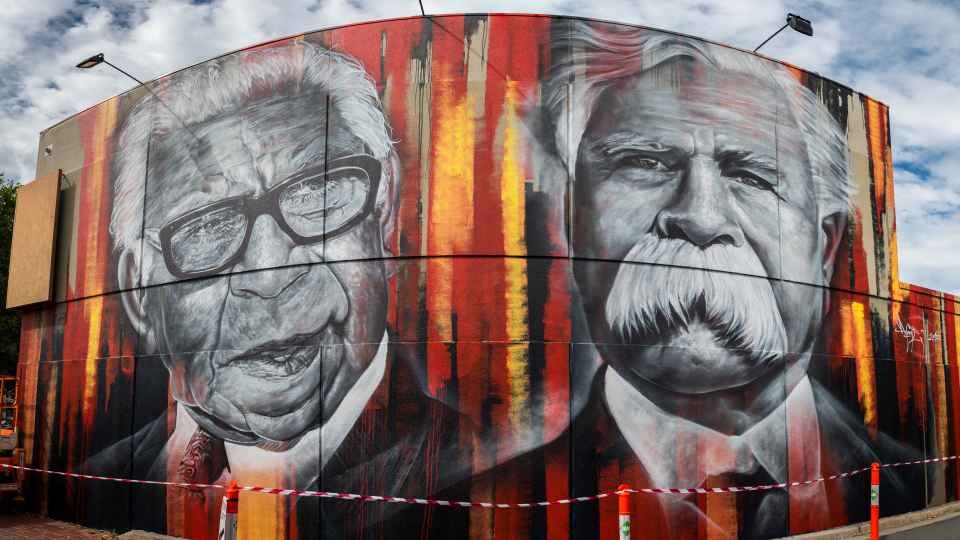Aboriginal Street Art Project
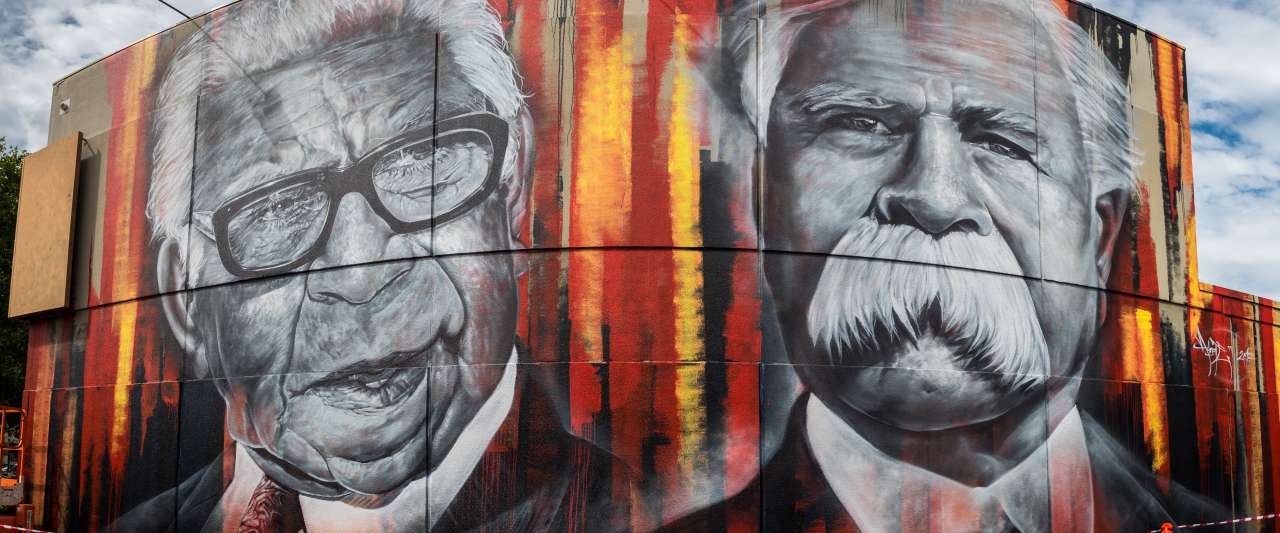
The Aboriginal history and culture is rich within the Greater Shepparton region and what a perfect theme for a street art project!
First Nations Peoples should be aware that this page contains the images and names of people who have passed away.
The Aboriginal Street Art Project has been named by locals as ‘Dana Djirrungana Dunguludja Yenbena-l’ which means ‘Proud, Strong, Aboriginal People’ in Yorta Yorta language. This project is aimed at celebrating the local Aboriginal history and culture within the region and also aims to connect the new SAM with the Shepparton CBD.
Background
In 2016, Greater Shepparton City Council came up with an idea to celebrate the local Aboriginal people and their culture through street art. Street art has become quite prevalent in Northern Victoria and if Greater Shepparton was to commence a street art project, it would be pertinent that the project links back to Greater Shepparton in some way.
Council, in discussion with the local Aboriginal community, noticed an interest amongst the locals in recognising significant figures who are not currently recognised within the region. Instead of the community putting their own hands up to potentially be featured within artwork, they felt it was much more pertinent to recognise their ancestors and significant elders that they look up to. The two names that popped up the most were Uncle William Cooper and Pastor Sir Douglas Nicholls.
Consultation began with Rumbalara Cooperative, Yorta Yorta Nation Aboriginal Corporation, the local Aboriginal community and the families of both Uncle William Cooper and Sir Douglas Nicholls.
Both individuals were approved to be featured within a mural through both the Yorta Yorta Aboriginal Corporation Elders Committee and the Rumbalara Cooperative Elders Committee.
Research regarding most suitable artists who have a proven record in painting large sized portraits of people commenced. Given the project was to feature portraits, it was incredibly important that the likeness is matched to a tee!
Stage One
Council commissioned well known artist Adnate to paint a mural dedicated to both the late William Cooper and the late Pastor Sir Douglas Nicholls KCVO OBE MBE. Adnate, who is widely recognised for his paintings in Sheep Hills, Benalla, Melbourne and throughout the world. Adnate specialises in working closely with local Aboriginal communities and has a passion for painting portraits that have a deep connection to local cultures and communities.
Goulburn Valley Water offered Council their wall on Fryers Street to showcase the first and second murals.
About Pastor Sir Douglas Nicholls KCVO OBE MBE
Pastor Sir Douglas Nicholls KCVO OBE MBE, who has an annual AFL round dedicated to him was born 9 December 1906 at the Cummeragunja Reserve and was a prominent Aboriginal from the Yorta Yorta people and is known to many as ‘Uncle Doug’.
Sir Douglas Nicholls was the first Aboriginal person to be knighted and in 1976 was made Governor of South Australia. Earlier, during the commencement of his football career for Fitzroy, Sir Douglas Nicholls was subjected to on field taunts and ostracised by his team-mates due to his colour. Sir Douglas Nicholls was at an early stage changing in a separate change room to his team mates until he was befriended by team mate Haydn Bunton who ensured Nicholls was made welcome within the Fitzroy Football Club team.
Sir Douglas Nicholls, due to his skill, vision and lighting speed, became a popular player amongst the spectators and is now recognised as a football legend.
About William Cooper
William Cooper, born on 18 December 1860 and known to many as Uncle William Cooper was an Aboriginal political activist and community leader.
William Cooper who was a Yorta Yorta man, campaigned for Aboriginal rights, particularly land and is also recognised for protesting against the Nazi Government of Germany due to their poor treatment of the Jewish people. William Cooper led a delegation to the German Consulate in Melbourne to deliver a petition which is recognised as the only petition against the Germans following Kristallnacht. On 6 December 2008, the 70th anniversary of the protest against Kristallnacht, William Cooper's grandson, Alfred "Boydie" Turner, also known as Uncle Boydie was presented with a certificate from the Israeli Ambassador stating that 70 Australian trees were to be planted in Israel in honour of William Cooper.
29 March 2017 marked 76 years since William Cooper passed away in Mooroopna in 1941.
Stage Two
The first mural of Stage Two features on the wall of Goulburn Valley Water - just south of the mural depicting William Cooper and Pastor Sir Douglas Nichols. This mural was painted by Adnate - the same artist that painted stage one. The mural features Aunty Margaret Tucker MBE and Nora “Nanny” Charles - two significant past local elders.
The second mural of stage two features Private Daniel Cooper and acknowledges the contribution of local Aboriginal people in military service for the nation. Aboriginal people have a proud history of fighting in armed conflicts for Australia however initially were forbidden from joining the Army for conflicts such as World War I. It was only when the situation in Europe became more desperate and extra soldiers were required that Aboriginal people were permitted to enlist.
Despite sharing a common bond and equality on the battlefield, Aboriginal servicemen and servicewomen that survived the conflicts were subjected to injustice and inequality when returning to Australia. This mural pays tribute to local Aboriginal people who represented Australia in war and is a partnership between Greater Shepparton City Council, Yorta Yorta Nation Aboriginal Corporation, Rumbalara Cooperative and Shepparton RSL.
About Aunty Margaret Tucker MBE
Aunty Margaret Tucker MBE, a Yorta Yorta woman, was one of Australia’s first female Aboriginal rights activists and was highly active from the early 1930’s within the Australian Aborigines League (which she was involved in establishing) as well as holding many positions in different representative bodies and Government advisory groups throughout her life. Aunty Margaret, also known as Aunty Marge, spent much of her childhood at the Cummeragunja and Moonacullah Missions however was later taken away against her mother’s wishes and it wouldn’t be until years later that Aunty Marge would reunite with her family.
Aunty Marge worked alongside various Yorta Yorta representatives including William Cooper, Sir Douglas Nicholls, Bill and Eric Onus and also her younger sister Geraldine Briggs to advocate for the rights of Aboriginal people. Aunty Marge Tucker is currently on the Aboriginal Honour Roll and is admired by the local Aboriginal community for her continued efforts in supporting and advocating for her people. Aunty Marge spent her last years in a nursing home in Shepparton and died in 1996.
About Nora “Nanny” Charles
Nanny Nora Charles, a Yorta Yorta woman, was one of the earliest and best known local Aboriginal midwives.
She was renowned throughout the region for travelling up and down the Murray to camps and missions to assist in the delivery of babies at a time when Aboriginal women were not permitted access to hospitals or medical professionals.
Nanny Nora Charles participated in the Cummeragunja walk off and lived on ‘The Flats’ on the Goulburn River located between Mooroopna and Shepparton where she continued to deliver babies as a midwife.
Nanny Nora would later become a resident within the town of Shepparton where she continued to support the local Aboriginal community. She died at the age of 89.
About Private Daniel Cooper
Private Daniel Cooper was a Yorta Yorta man and fought for Australia during World War I. Private Daniel Cooper died on a European battlefield in 1917. He was just 21 years old and is buried in Belgium. Daniel Cooper was son of Yorta Yorta man Uncle William Cooper and Agnes Hamilton.
Private Daniel Cooper gazes across to the Queens Gardens where the statue of his father William Cooper stands.
While this mural pays respect to Private Daniel Cooper, the overarching purpose of the mural is much broader as it recognises all local Aboriginal people who represented Australia in war. Private Daniel Cooper is a local symbol and represents a story that is unknown by many Australians.
Between 800 and 1000 First Nations People served during World War I. Because cultural identity was not recorded in enlistment records, accurate figures might never be known.
At the time of World War I, young men were flocking to enlist, however Australia’s Defence Act of 1903 actually forbade Aboriginal people from representing Australia in war. Many young Indigenous recruits however did slip through by passing as ‘non’ Aboriginal.
It wasn’t until October 1917 (during World War I), when recruits were harder to find and the Government was becoming desperate for numbers, that this requirement was relaxed a little. A new Military Order stated: "Half-castes may be enlisted in the Australian Imperial Force provided that the examining Medical Officers are satisfied that one of the parents is of European origin."
Newspaper reports from the war period suggest that over 100 men from Cummeragunja had enlisted. Some of these stories have been recorded as part of the Victorian Aboriginal WWI Service Research Project.
Once enlisted, Aboriginal servicemen were treated as equals. Their pay was the same and for perhaps the first time, they were generally accepted without prejudice.
But once World War I ended, First Nations servicemen once again faced discrimination in all areas of life. They were excluded from soldier settler land grants, denied membership of returned servicemen’s clubs and their names were not included on memorials.
Stage Three
Stage 3 of Greater Shepparton City Council’s Aboriginal Street Art project was a joint project with the Department of Health and Human Services (DHHS) and Yorta Yorta Nation Aboriginal Corporation (YYNAC).
DHHS approached Council with the intention of recognising the local Aboriginal community through the Aboriginal Street Art project by having a mural painted on its wall.
Council consulted YYNAC, with its board of Elders determining they would like to recognise two significant female Elders in the late Aunty Geraldine Briggs and the late Aunty Elizabeth Morgan.
Both women are highly regarded Yorta Yorta Elders and were heavily involved in the advocating of rights and support for Aboriginal people.
The mural on the DHHS wall was painted by returning artist Adnate, who also painted the murals on the Goulburn Valley Water wall. Adnate is regarded highly amongst the local Aboriginal community due to his previous work and dealings with locals. The mural on the DHHS wall fronting Welsford St overlooks the Goulburn River and river gums.
About Aunty Geraldine Briggs
Aunty Geraldine Briggs is a highly respected Aboriginal Elder amongst local, state and national Indigenous communities. She put all of her energies into supporting and raising her eight children and extended family members, whilst campaigning for equal rights, particularly concerning citizenship.
She was a founding member and past president of the National Council of Aboriginal and Islander Women. Geraldine was the state secretary and a member of the Federal Council of Aboriginal and Torres Strait Islanders who campaigned for the 1967 constitutional referendum relating to Aborigines and the vote. Geraldine was buoyed up by the hope of a better future for Aboriginal Australians when more than 90 per cent voted in favour of the 1967 constitutional amendments.
Aunty Geraldine received the Order of Australia and was placed on the inaugural Victorian Women’s Honour Roll in the year of the Federation. Geraldine is listed on the inaugural Victorian Aboriginal honour roll due to her achievements and at 82 years of age she won the Aboriginal of the Year Award.
About Aunty Elizabeth Morgan
Aunty Elizabeth Morgan was born at Cummeragunja and witnessed the walk off at a young age. Elizabeth worked tirelessly in improving the lives of her Aboriginal People especially women and children. During her time as Director of the Aborigines Advancement League she co-founded the Aboriginal Housing Cooperative in 1974, the Victorian Aboriginal Child Care Agency and many other vital services such as Australia’s first Aboriginal refuge which would later be named in her honour as Elizabeth Morgan House. In her later years she fought for the recognition of the Yorta Yorta Nation of which her legacy stands today.
Elizabeth had many achievements and received an inaugural NAIDOC Lifetime Achievement Award in 2006 after being inducted into the Victorian Women’s Honour Roll in 2001. In 2017 she was inducted into the Victorian Aboriginal Honour Roll.
Stage Four
Stage Four of Greater Shepparton City Council’s Aboriginal Street Art project, in consultation with YYNAC, recognises two significant Yorta Yorta female Elders, the late Aunty Violet Harrison and late Aunty Mary James. Both ladies are highly regarded local Yorta Yorta Elders and were heavily involved in supporting the local Aboriginal community and abroad.
Goulburn Valley Water has kindly offered their wall on Welsford Street for this mural given their ongoing support for both the Aboriginal Street Art Project and the Aboriginal community the project continues to recognise.
The mural, overlooking the CBD, was painted by returning artist Matt Adnate who is highly regarded amongst the local Aboriginal community due to his previous work and positive dealings within the region.
About Aunty Violet Harrison
Aunty Violet Harrison was born on 24 January 1906 at the Cummeragunja Mission and was the mother to 13 children. She was one of the founding members of the Rumbalara Cooperative, one of the founding members of what was at the time the Shepparton Aboriginal Keeping Place and a long standing member of the Greater Shepparton Aboriginal community.
About Aunty Mary James
Aunty Mary James was born on 5 October 1913 at the Cummeragunja Mission and was the mother to 14 children. She was one of the founding members of the Rumbalara Cooperative, one of the founding members of the Shepparton Aboriginal Funeral Fund, one of the founding members of the Community Care Program through the Methodist Church, a member of the Rumbalara Housing Board, one of the founding members of the Shepparton Justice and Police Liaison Unit and one of the founding members of what was at the time the Shepparton Aboriginal Keeping Place.


